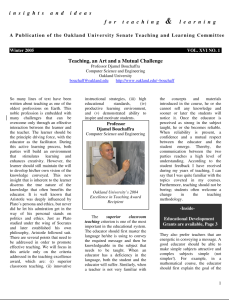Teaching: an Art and a Mutual Challenge
So many lines of text have been written about teaching as one of the oldest professions on Earth. This noble profession is embedded with many challenges that can be overcome only through an effective interaction between the learner and the teacher. The learner should be the principle driving force, with the educator as the facilitator. During this active learning process, both parties will build an environment that stimulates learning and enhances creativity. However, the learner should still maintain the will to develop his/her own vision of the knowledge conveyed. This newinsight that is inherent to the learner discerns the true nature of the knowledge that often benefits the educator. It is well known that Aristotle was deeply influenced by Plato’s persona and ethics, but never did he let his admiration get in the way of his personal stands on politics and ethics. Just as Plato studied under the wing of Socrates and later established his own philosophy, Aristotle followed suit. There are several points that need to be addressed in order to promote effective teaching. We will focus in this article only on some of the most important criteria, which are: (i) superior classroom teaching, (ii) innovative instructional strategies, (iii) high educational standards, (iv) productive learning environment, and (v) demonstrated ability to inspire and motivate students. The superior classroom teaching criterion is one of the most important in the educational system. The educator should first master the language he/she is using to convey the required message and then be knowledgeable in the subject that needs to be taught. When an educator has a deficiency in the language, both the student and the educator will suffer. Similarly, when a teacher is not very familiar with the concepts and materials introduced in the course, he or she cannot sell any knowledge and sooner or later the students will notice it. Once the educator isperceived as strong in the subject taught, he or she becomes reliable. When reliability is present, a confidence and a mutual respect between the educator and the student emerge. Thereby, thecommunication between the two parties reaches a high level of understanding. Furthermore, teaching should not be boring; students often welcome a change in the teaching methodology.They also prefer teachers that are energetic in conveying a message. A good educator should be able to make simple subjects attractive and complex subjects simple (not simpler!).
One of the main questions often raised by educators and instructors is how to teach classes that are heterogeneous in terms of their level of knowledge and ability? In other words, how can one convey (or emit) the same message to different receptors? For some students, the knowledge conveyed can be very obvious and therefore boring; for others, it can be too challenging and therefore can disconnect them. This epistemological issue is not easy to solve, I personally divide students into groups made of four or five students. To balance the group and reach a certain level of homogeneity, I gather strong and weak students within the same group.
To get the complete article on my teaching philosophy, please click on the image below
In February 2005, he was invited by OU-TV “Focus on Faculty Program” broadcasted on Comcast cable channel 74:
